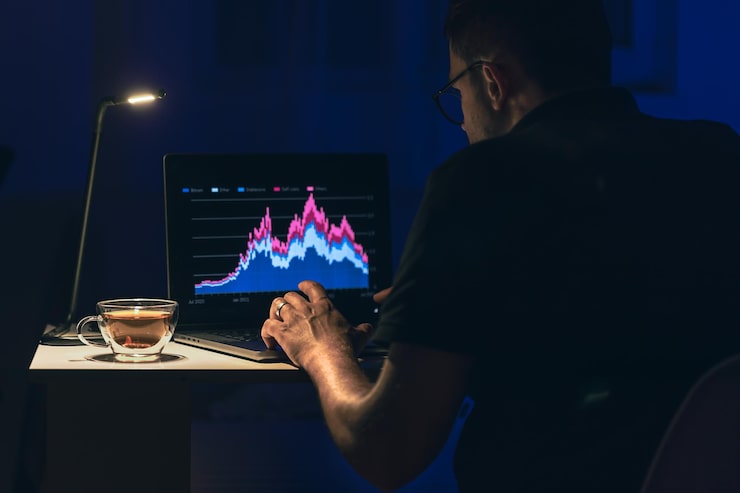Day Trade Gold Futures

There is a moment every new trader remembers. The charts open, the first few ticks move faster than expected, and suddenly you understand why people talk about gold futures with a mix of respect and curiosity.
The market has a rhythm that challenges your attention in a way few other products do. Anyone can feel that spark when the price shifts a few points. What determines whether it becomes progress or pressure is how well you understand what the contract is trying to tell you.
Day trading gold futures draws people who appreciate clear movement. The contract reacts with speed, yet the drivers behind that speed are usually tied to events you can track if you pay attention. Once you understand this, the confusion fades. Experiencing that shift from chaos to structure is motivating for many traders.

Our Mission
To make gold and crypto trading accessible by providing clear guidance, reliable information, and practical tools. We aim to support traders at every level with straightforward resources that simplify complex markets.

Our Vision
To become the most trusted online destination for gold and crypto trading education, helping traders worldwide grow their knowledge, improve their strategies, and stay ahead of market opportunities.

How Gold Futures Operate Beneath the Surface
Understanding the Structure of the Contract
A gold futures contract looks simple on the surface, yet every detail inside it can influence how a trading day unfolds. The size of the contract, the tick value, and the margin requirement all shape how the market feels once you place a position. These elements are fixed, which means you can measure the potential impact of each trade before you click. Many traders overlook this and end up surprised when a price move that seems small on the chart causes a meaningful change in their account. The contract reacts quickly, and that speed becomes easier to work with when you know exactly how each tick translates into real currency.
Once you take the time to learn how the contract is built, the movement on the chart starts to make more sense. Gold futures tend to respond strongly to global events, but they also follow a clear framework set by the exchange.
This combination of structure and volatility creates the environment in which day traders operate. Those who understand the mechanics feel more grounded during active sessions. Those who skip this step often find themselves overwhelmed when the market picks up speed. The goal is not memorization. It is comfort. Familiarity with the contract lets you focus on reading the market rather than fearing sudden shifts.
How This Knowledge Supports Intraday Decisions
Traders who understand the inner workings of gold futures often carry a calm presence when volatility rises. The chart may move quickly, but they already know the financial impact behind each shift. This clarity helps them stay composed and prevents impulsive reactions during sharp swings.
When you understand how margin can influence both gains and losses, you are far more likely to choose position sizes that match your skill level. This leads to steadier decision-making, especially when unexpected news hits the market.
Awareness of contract structure also allows you to recognize when a move is meaningful and when it is simply noise. You can sense the difference between a natural pullback and a price swing that signals a change in sentiment. This comes from experience, but it begins with a solid grasp of how the product works. Once you build that foundation, intraday trading feels less intimidating. You approach the chart with a clearer mindset and respond with intention rather than stress.
Why Simplicity in Charting Helps You Think Faster
Clarity That Supports Quick Interpretation
New traders often assume that additional indicators will lead to better results. With gold futures, the opposite tends to be true. The contract moves quickly, which means you need to read the chart without hesitation. A screen packed with oscillators, overlapping lines, and conflicting signals slows you down at the exact moment clarity matters most.
When you remove this clutter, the chart becomes easier to understand. You can see where price respected earlier highs and lows, how volume behaved near turning points, and whether buyers or sellers are gaining strength.
This simplicity creates a calm environment for decision-making. You’re not trying to decode five different indicators at once. You’re reading the story of price movement in real time. Clean charts help your eyes settle on what matters. You begin to recognize when a breakout has conviction or when it is losing strength. You notice how gold futures react during quiet hours compared to active ones. This awareness builds confidence, and confidence helps you focus on the right trades rather than the flashy ones.
A Cleaner View of Market Behavior
A simple chart means you are filtering out noise so that the most essential signals stand out. When you pay attention to levels formed earlier in the day, you begin to see how the market respects certain prices. When you watch volume alongside price movement, you notice which moves have support behind them. This information is far more valuable than an indicator that lags or contradicts what the price is already showing.
Traders who take this approach react with more precision. They decide based on current information instead of waiting for a delayed signal. They also avoid the frustration that comes from relying on indicators that obscure the actual movement of gold futures. A clean chart helps you stay present and aware, and awareness is one of the most valuable skills a day trader can develop.
Once you experience the clarity that simplicity brings, complex setups lose their appeal. You begin to trust your own interpretation, and that trust becomes a quiet source of strength.
Timing the Market When Liquidity Comes Alive
Recognizing When Gold Futures Gain Strength
Gold futures don’t behave the same way throughout the trading day. Some hours feel quiet, almost hesitant, while others suddenly show confident movement. Traders who spend enough time observing the flow notice a clear pattern in how activity aligns with global financial centers.
When major markets operate at the same time, volume tends to rise, and orders move through the book with greater clarity, helping traders read intent. During these periods, price movement reflects genuine participation rather than scattered activity, and this can create an environment where entries feel more deliberate.
The increase in volume during active hours brings movement and adds structure. A clean stream of orders reveals whether buyers or sellers hold short-term control. You can sense when a level might break or when a pullback might form.
This type of transparency helps traders make decisions with a calm mindset rather than relying on guesswork. When the market opens up and provides reliable liquidity, traders often feel more connected to what the chart is showing.
Avoiding the Temptation of Thin Sessions
On the opposite end, thin or quiet sessions can test discipline. When gold futures drift without conviction, traders sometimes feel pressure to take trades simply to stay busy. This is when mistakes tend to multiply.
With limited participation, the price may move in ways that appear meaningful but lack true strength. Signals that look valid on the surface often fade quickly, and entries taken during such periods rarely follow through.
Patience becomes the defining factor in these situations. The traders who learn to wait for genuine liquidity avoid the frustration of trading random noise. They build a rhythm based on quality, not activity. Passing through a quiet period without taking unnecessary trades feels unsatisfying at the moment, but it protects long-term results.
Once the active sessions return, opportunities appear more structured, and the effort spent waiting suddenly feels worth it. Over time, this approach leads to consistency that outlasts the rush of forced entries.
Catalysts That Shape Intraday Movement
Understanding How Key Events Influence Gold Futures
Gold futures react quickly to changes in economic conditions, and these reactions significantly shape intraday behavior. Traders who follow scheduled releases gain a clear advantage because they know when volatility may pick up.
Reports on inflation, interest rate expectations, payroll changes, and currency movements often serve as sparks that shift market sentiment. These updates may arrive at predictable times, but their impact can extend far beyond the initial moment.
Knowing when these events occur helps traders decide whether to participate or step aside. A trader who enters right before a high-impact release may encounter sudden movement that doesn’t align with their plan. Meanwhile, another trader who waits for the reaction may see the direction more clearly. Understanding how these catalysts influence gold futures allows you to frame the trading day with intention. The market doesn’t move at random. It reacts to information that you can prepare for.
Using Awareness to Maintain Control During Volatility
When a major update hits the market, gold futures often respond with a burst of energy that can catch unprepared traders off guard. Some prefer to stand aside until the surge settles, while others look for signs that confirm the new direction. Either method can work when applied consistently. What keeps traders grounded during such moments is the awareness that the movement comes from identifiable causes rather than sudden chaos.
This awareness creates confidence during uncertain periods. Instead of feeling overwhelmed by fast price shifts, you recognize that the market is processing new information. You begin to see patterns in how gold futures behave after these announcements. Sometimes the first reaction fades, and the real move forms afterward. Other times, the initial surge holds its direction. With experience, you learn to read the tone of the reaction.
The more familiar you become with these catalysts, the less the market feels unpredictable. You respond with steady judgment instead of rushing into decisions. This steadiness allows you to approach gold futures with a clear mind, even when volatility rises without warning.
Building Structure Around Each Trade
Creating a Framework Before You Enter
Trading gold futures without structure is similar to walking into fast traffic without a plan. The market moves quickly, and that pace can distort your judgment if you rely on impulse. A clear framework prevents this. Before you enter, you should know your exit for both loss and gain.
These decisions guide your actions during the trade, especially when the price begins to fluctuate. Without this foundation, the natural speed of gold futures can push you into choices that drift far from your original intention.
A structured plan helps you stay disciplined when movement becomes unpredictable. You’re not deciding as the pressure increases. You’re following the steps you set beforehand during a calm state. This keeps your trading consistent and reduces the emotional tension that often leads to poor decisions.
A framework also enables you to evaluate performance accurately. When each trade follows the same process, you can pinpoint what works and what needs adjustment. Over time, this structure becomes the anchor that steadies your approach.
Recognizing Patterns in Session Behavior
Structure does not end with risk parameters. It also includes observation. When traders study how gold futures behave during the session, they begin to identify areas where buyers or sellers tend to take control.
You may notice that certain price levels attract sharp reactions or that pullbacks behave differently during active hours. These observations form a practical guide for future decisions.
Once you start identifying these behaviors, your structure gains depth. You’re not guessing where strength might appear. You’ve seen how the market reacts during similar setups. This awareness helps you avoid chasing moves that have already played out. It also keeps you patient when a trade is not ready yet.
Combining predefined boundaries with session-based observations creates a trading environment where decisions feel deliberate rather than rushed. This kind of structure leads to consistent progress because it grows from real experience rather than shortcuts.
Managing Leverage With Realistic Expectations
Understanding How Exposure Shapes Your Mindset
Leverage is one of the most attractive features of gold futures, yet it is also one of the most challenging. The ability to control a prominent position with a relatively small amount can feel empowering, but it can also distort your sense of risk. When exposure is too significant, even a slight pullback can trigger anxiety. This tension affects your decision-making long before your strategy has a chance to unfold. The goal is not to stretch leverage to its limit. It is to use it in a way that supports consistent trading.
A realistic approach to leverage sets the tone for everything that follows. When your position size aligns with your comfort level, you think more clearly. You can evaluate price movement without fear clouding your judgment. Traders who maintain this balance often find it easier to handle abrupt movements in gold futures because their exposure does not overwhelm them. The market feels challenging, but not threatening, and this emotional stability improves performance.
Finding Clarity Through Moderate Sizing
Many traders notice a sharp improvement in their results once they reduce their position size. Smaller exposure gives you space to think. That space allows you to follow your plan without the constant pressure of potential loss. When you remove excessive size from the equation, the chart becomes easier to read. You start to notice subtle shifts in momentum and behavior that were previously hidden by stress.
Moderate sizing also supports long-term growth. If every trade carries a balanced level of risk, you can participate in the market day after day without feeling drained. You preserve both your capital and your focus.
Gold futures will always produce fast movement, but you don’t have to match that speed with reckless size. A calm mindset leads to accurate interpretation, and accurate interpretation leads to consistent results. Leverage becomes a tool rather than a source of pressure. When used responsibly, it helps you develop the steady rhythm that successful trading depends on.
The Role of Emotional Awareness in Day Trading
Seeing How Emotions Shape Split-Second Choices
Gold futures reveal emotional patterns more quickly than almost any other asset because the market moves at a pace that rarely gives traders room to hide. Even small candles can stir reactions that feel stronger than the situation warrants. A quick pullback can tighten your chest. A sudden spike can create excitement that pushes you into trades you never planned to take. These reactions happen before you realize it, which is why emotional awareness becomes a core skill rather than a soft concept.
When you slow down long enough to acknowledge what you are feeling, you begin to understand how much of your decision-making is driven by instinct rather than logic. A trader might watch a small pullback and exit a perfectly valid trade out of fear.
Another trader might cling to a losing position because they want the market to correct itself.
Both situations show how strong emotions can be, but they also show something else. They reveal where your attention needs to go. Every uncomfortable reaction is an opportunity to understand what triggers you and how to reduce its influence. Over time, this awareness helps you create distance between your thoughts and your actions.
Turning Emotional Insight Into Steady Performance
Awareness means little unless you use it to adjust behavior. Once you recognize your emotional habits, you can interrupt them before they affect your trades. This creates a sense of control that doesn’t rely on market conditions. The chart may move quickly, but your response doesn’t have to keep pace. When you pause, you give yourself a chance to make a decision based on your plan rather than your nerves. That pause, small as it is, becomes a quiet edge.
As this awareness grows, your trading style becomes steadier. You no longer see every move as a threat or every opportunity as something urgent. You begin to trust your preparation.
You learn that the market will always produce moments that trigger emotion, but those moments do not need to dictate your actions. With time, your confidence comes from understanding yourself as much as it does from understanding gold futures. This creates a foundation that supports long-term consistency.
How Consistency Develops With Experience
Building Familiarity Through Repetition
Consistency in day trading rarely appears in the early stages. It develops through repeated exposure to similar situations until patterns begin to make sense. Gold futures offer many opportunities for this because the contract reacts to news, volume shifts, and session timing in ways that become recognizable with experience.
At first, these movements may feel unpredictable, but with time, you notice rhythm in how the price behaves. You begin to see how momentum forms before a breakout and how hesitation creeps in before a reversal. What once felt chaotic becomes something you can read with confidence.
Every trading day offers small details that deepen your understanding. You notice how the price responds when it approaches a familiar level. You observe how volume behaves during active periods.
You learn how quickly sentiment can shift during economic releases. These observations create a mental library that helps you identify setups more speedily and with greater confidence. Instead of reacting to each candle independently, you interpret movement within a broader context. This familiarity removes much of the guesswork that can frustrate newer traders.
Developing Trust in Your Own Process
As your comfort with gold futures grows, your approach becomes less reactive. You stop chasing moves that have already played out. You wait for conditions that match your method instead of forcing entries because you fear missing out. This patience does not come from caution. It comes from trust. You understand that quality setups appear regularly enough that waiting is not a risk, but a strength.
Consistency takes hold when your choices align with clear reasoning. Wins feel justified, and losses feel manageable because they were part of a planned approach. Over time, you rely less on predictions and more on observation. You stop trying to outsmart the market and start focusing on reading what is actually present. When each decision reflects a process you believe in, confidence grows naturally. This is the point where trading begins to feel steady rather than frantic. You are no longer seeking perfection. You are aiming for control, clarity, and progress, which is exactly what sustained consistency requires.
Day trading gold futures becomes sustainable when structure, timing, patience, and emotional awareness work together. The market will always move in ways you cannot fully control, but your behavior can remain steady. When you approach the chart with preparation and a clear plan, progress feels natural rather than forced.
If you want more support as you refine your approach, you can explore research tools, market updates, and broker insights from Trade Gold Online, which offers a range of educational resources for traders who follow gold markets.


